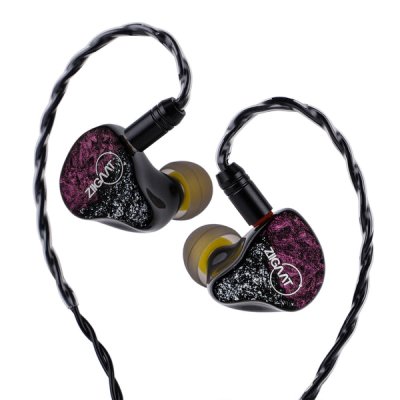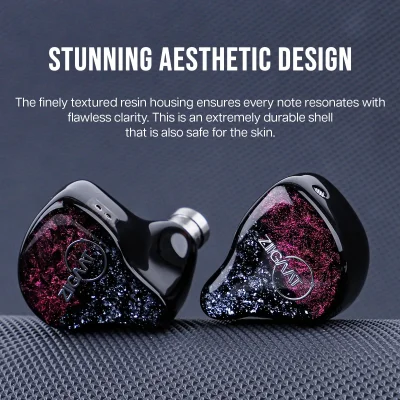Ziigaat Odyssey and FatFreq x HBB Deuce use 1DD+3BA and 2DD driver setups respectively. Ziigaat Odyssey costs $229 while FatFreq x HBB Deuce costs $239. FatFreq x HBB Deuce is $10 more expensive. Ziigaat Odyssey holds a clear 0.5-point edge in reviewer scores (7.7 vs 7.2). Ziigaat Odyssey carries a user score of 7.4. Ziigaat Odyssey has better bass with a 0.5-point edge, Ziigaat Odyssey has significantly better mids with a 1.3-point edge, Ziigaat Odyssey has significantly better treble with a 1.8-point edge, Ziigaat Odyssey has significantly better dynamics with a 1-point edge and Ziigaat Odyssey has significantly better soundstage with a 1.5-point edge.
Insights
| Metric | Ziigaat Odyssey | FatFreq x HBB Deuce |
|---|---|---|
| Bass | 7.5 | 7 |
| Mids | 8.3 | 7 |
| Treble | 7.3 | 5.5 |
| Soundstage | 7.5 | 6 |
| Dynamics | 7 | 6 |
| Tonality | 7.8 | 7 |
| Technicalities | 7.1 | 6.1 |
Ziigaat Odyssey Aggregated Review Score
Average Reviewer Scores
Average Reviewer Score:
7.7Strongly Favorable
FatFreq x HBB Deuce Aggregated Review Score
Average Reviewer Scores
Average Reviewer Score:
7.2Generally Favorable
Reviews Comparison
Ziigaat Odyssey reviewed by Jaytiss
Youtube Video Summary
Single-DD + 3BA hybrid with a clean, confident look: thick shell, metal nozzle that grips tips well, visible rear vent, and the preferable flat 2-pin connector. The standard Ziigaat case feels premium if a bit unexciting. Sonically, Odyssey lands a balanced, tastefully energetic tuning—ample bass for most listeners, elevated upper mids for presence, and a smooth, clean upper-treble. Out of the box it sounds immediately right and counts among the better-tuned sub-$300 IEMs. The catch: macro/micro detail and imaging are good, not mind-blowing, keeping overall technical performance at “appropriate for the price.”
Within Ziigaat’s lineup, Arcadia skews darker with less treble reach, Xeno/Ceno feels a bit treble-shy, and Dinko is the more V-shaped, poppier pick with extra sub-bass. Explorer overlaps in tonality but Odyssey adds more upper-mids energy and refinement—albeit at a higher price. Among peers, AFUL’s P7 brings the stronger technicals and a slightly more neutral sheen, K4 trades blows, and “Quattro” may edge tuning purity. As an all-rounder, though, Odyssey hits a sweet spot: rich mids, fun but controlled bass, convincing note weight, and a natural stage, even if the far-upper air can temper ultimate sparkle.
Verdict: a fantastic mid-tier set with high price-to-performance, gorgeous faceplates, and a crowd-pleasing tonality; accessories are a bit underwhelming, and the top-end “air” won’t wow technicality chasers. Scored around 8.8/10 and easily recommended as a safe, musical choice—especially when discounts bring the sticker down.
Jaytiss Youtube Channel
Buy Ziigaat Odyssey on Linsoul
Ad
Price: $229
Buy Ziigaat Odyssey on Linsoul
FatFreq x HBB Deuce reviewed by Jaytiss
Youtube Video Summary
FatFreq x HBB Deuce brings a compact, comfortable shell with a gray metallic finish and easy tip fitment; ergonomics and weight are spot-on. Packaging is straightforward but solid, and the stock cable is decent—secure chin slider and tidy Y-split—though a bit microphonic. The recessed 2-pin connector can be fragile if carelessly handled; a replacement unit solved earlier issues. A standout extra is the included impedance adapter (4.4mm), which meaningfully alters drive and response.
Sonically, this is a double dynamic driver set tuned for excitement: clean mids with realistic note weight, lively upper presence, and genuinely pleasing air and sparkle. The hallmark is a colossal bass shelf beginning around ~200 Hz—punchy, tactile, and sometimes “pop-out-of-nowhere” feisty. With the adapter, expect roughly ~10 dB more low-end and a need for a couple volume clicks, turning it into full-on guilty-pleasure territory. Despite the bass emphasis (and a slight “tuck” sensation), vocal presence stays intact and timbre remains cohesive for a DD-driven set.
Against FatFreq siblings and peers, Deuce feels more controlled than Scarlet Mini’s later-rising low shelf, cleaner and more coherent than Maestro Mini, and trades blows with Black Up while echoing some of the top-end fun found in Grand Maestro. Versus higher-priced favorites (e.g., Jupiter, Binary Dynaquattro), it gives up some refinement/extension but returns remarkable value around ~$240. For those craving “gigachad” bass without wrecking the mids, this is a distinctive, versatile daily that suits many genres and feels special at the price. Final take: a strong 87/100 and one of the most enjoyable recent HBB collabs—imperfect, yes, but thrilling and highly recommended for bass-inclined listeners.
Jaytiss Youtube Channel
Ziigaat Odyssey reviewed by Bad Guy Good Audio
Bad Guy Good Audio original ranking
Bad Guy Good Audio Youtube ChannelFatFreq x HBB Deuce reviewed by Bad Guy Good Audio
Youtube Video Summary
FatFreq x HBB Deuce targets a very specific brief: the most affordable, most balanced, yet still impactful member of the Maestro line—built without balanced armatures and tuned with a Variations-style contour but with more slam. Low end checks the boxes across hip-hop and rock staples; 4/5-string bass lines have clean pull and ring, and the kick has that produced Bonham thump on “When the Levee Breaks.” Vocals—think Chris Cornell, Layne Staley, and Nina’s “Heart of Glass”—stay clear of bass bleed, the result of multiple physical sample rounds and FatFreq’s unique Bass Cannon V2 implementation. Overtones pop—electric/acoustic guitar, rides, crashes, keys—and the set delivers an unusually wide stage that holds up over long sessions.
The tuning philosophy mirrors the Moondrop Variations energy but hits harder via driver venting/porting and crossover work rather than brute mid-bass lifts, preserving rhythm section weight without trampling vocals. That balance is the point—male and female vocals ride on top while bass and drums punch underneath. There’s an optional impedance optimizer that morphs the Deuce toward a Scarlet Mini vibe for bigger slam, but it trades away some vocal finesse; it’s a fun switch for bassheads, not the intended baseline. Ignore the “25 dB” chatter—this collab’s goal wasn’t a bass-monster badge, it was a coherent, musical daily driver that crosses genres.
As a package, Deuce looks the part, leverages FatFreq’s latest bass tech, and offers a value gateway into the brand that can hang with pricier siblings. The default tuning brings the slam-without-bloat many wanted, while the adapter exists for those who crave extra rumble. With strong word-of-mouth and real-world playlists backing it, this feels like a lovable set in either configuration—one for balance and clarity, one for pure grin-inducing heft.
Bad Guy Good Audio original ranking
Bad Guy Good Audio Youtube ChannelZiigaat Odyssey reviewed by Jays Audio
Youtube Video Summary
Ziigaat Odyssey lands as a mid-range focused set with a slight treble lift that really scales with volume. At relaxed levels it’s clean, calm, and easygoing; turn it up and the presentation becomes wide, airy, and immersive with a surprisingly punchy, rumbly low end for its graph. The new topology DD hits a sweet balance—neither sluggish nor hyper-snappy—delivering well-balanced bass that serves the tuning, even if ultimate slam/texture trails sets like Hype 4 or Xenns Tea Pros. Tip rolling toward slightly brighter tips adds a touch of treble energy and liveliness without pushing fatigue.
The star here is the midrange: instruments layer neatly with comfortable separation, and vocals sit clean and natural—not shouty, not veiled—though they can feel a bit too relaxed at mid volume. Treble is smooth yet detailed, revealing cymbal micro-info and air without harshness, and it’s noticeably cleaner than Explorer while avoiding metallic timbre. Technicals are solid for the price—a step up from Explorer and just behind “contet” in raw resolving power—yet more natural in timbre and notably more musical when driven louder. The tuning flatters slow rock, acoustic, indie, alternative, and ballads, where the Odyssey’s “turn-it-up” character shines.
For alternatives: those wanting warmer, bassier impact for hip-hop, rock, or metal may prefer Kiwi Ears K4, HBB Arcadia, or the Deuce for true bass-head needs. For mid-volume all-rounders with more instant engagement and technical pop, consider Supermix 4, Nova, Quintet, or Chopin; for airier, brighter takes with sweeter female vocals, look at Cadenza 4 or CKLVX. As a package, Odyssey feels like a future classic—gorgeous plating, a cable that could use an upgrade, and a uniquely immersive, high-volume experience that invites shutting out the world and sinking into the music.
Jays Audio Youtube Channel
FatFreq x HBB Deuce reviewed by Jays Audio
Youtube Video Summary
Pre-order chaos aside—months of delays, a mixed-up shipment, and widespread complaints about customer service—the FatFreq x HBB Deuce answers the only question bass fans care about: low-end authority. This tuning is a sub-bass-first sledgehammer with a thick, heavy texture and a slightly prolonged decay that adds extra rumble and “reverb” feel. Despite the graph dip discourse, the mids don’t sound hollow, and the mid-bass isn’t neutered—just less punch-centric than the sub-bass focus. Vocals stay reasonably clean, avoiding the fuzzy bleed heard on some rivals, while the upper-mids/treble run smoother and more relaxed than edgier basshead sets. If the optional impedance adapter is used, expect even more low-end emphasis.
On technical performance (~$200 class), this is not the detail, separation, or imaging benchmark; more balanced competitors retrieve more information and stage more cleanly. Where Deuce shines is fun factor: hip-hop, rap, and EDM benefit from the cavernous sub-bass and weighty slam. A curveball comparison is the ultra-budget E20 (2DD), which can measure up with quicker bass, clearer upper-mids, better treble extension, and generally sharper resolution—especially with EQ—but it won’t dig as deep or hit as heavy as Deuce. Net: for a no-EQ basshead pick under $300, Deuce is a guilty pleasure—just buy from reputable retailers (e.g., Amazon/Linsoul) rather than direct, given the fulfillment troubles reported by many users.
Jays Audio Youtube Channel
Ziigaat Odyssey reviewed by Head-Fi.org
FatFreq x HBB Deuce reviewed by Head-Fi.org
Ziigaat Odyssey (more reviews)
Ziigaat Odyssey reviewed by Audio Amigo
Youtube Video Summary
Ziigaat Odyssey comes in at $230 with a four-driver hybrid (1DD + 3 BAs) that’s very easy to drive. Build is the usual Ziigaat: full 3D-printed resin shells with metal nozzles and filters; sturdy and comfortable for average-to-larger ears, while tiny ears get a technical pass. The weak spot is the accessories: a basic cable (3.5mm or 4.4 option), one set of soft silicone tips plus foams, and a leatherette case that feels flimsy—underwhelming at this price. Aesthetics score well with a sparkly faceplate that the “Council of Ladies” mostly favors, even if it doesn’t always trigger compliments.
Sonically, Odyssey aims for warm-neutral with a tasteful bass boost. Sub-bass texture can run a touch soft, but mid-bass punch is addicting, giving kick drums and bass guitars real drive without boom. Lower mids are warm and slightly veiled in a pleasant, retro-leaning way; female vocals sit a bit back yet remain clean. Treble is safe but present—enough sparkle and clarity to balance the bass without sting, though true treble-heads may want more air. Technicals are solid for the bracket: good resolution, excellent separation, precise imaging, and an average-sized but convincing stage. With a 15–30Ω adapter, the FR tilts more V-shaped (more bass/upper-mids/treble), a fun twist for occasional variety.
Against peers, Odyssey is the relaxed, safer listen: warmer and less contrasty than EPZ P50 (brighter, more vocal-forward) and Kiwi Ears K4 (more V-shaped excitement), and a middle ground between AFUL Explorer (darker, bassier) and AFUL Performer 5+2 (airier, more resolving with stronger female vocals). Not the pick for bass-heads, treble-heads, or libraries packed with K-/J-pop divas, but a killer one-and-done all-rounder for mixed libraries that value warmth, balance, and zero fatigue. Despite the skimpy pack-ins, the tuning and performance earn a spot in “this is brilliant.”
Audio Amigo Youtube Channel
Ziigaat Odyssey reviewed by Tim Tuned
Youtube Video Summary
Ziigaat Odyssey takes the new Meta tuning and gives it a more V-shaped, exciting twist. It keeps the beautiful mid-range intact while adding extra energy to both bass and treble, landing closer in spirit to Moondrop x Crinacle Dust (DSP) and Kiwi Ears K4—but with more swagger. It’s not as strictly on-target as those sets, yet the result is more engaging and solves the “too safe, sometimes boring” side effect of many Meta-tuned IEMs.
Beyond tuning, Odyssey brings real upgrades in technical performance for the price. Bass dynamics are punchier and more well-defined than K4, and treble nuances come through with greater clarity while preserving that natural vocal center. At $229, it undercuts many competitors and still feels like a step up—an easy pick for listeners who want Meta’s mid clarity with extra excitement and better slam without sacrificing coherence or comfort.
Tim Tuned Youtube Channel
Ziigaat Odyssey reviewed by
 Fresh Reviews
Fresh Reviews
Youtube Video Summary
Ziigaat’s 2024 lineup lands three distinct flavors: the R (1DD+4BA), Arcadia (1DD+2BA), and Odyssey (1DD+3BA)—all sharing the same case, tips, and cable, but with very different tunings and striking faceplates. Pricing lives in the approachable range (roughly $200–$250), and the shells are well-built 3D-printed resin. The Odyssey’s nozzle appears slightly wider than the R’s, and its cloudy pink/silver faceplate looks clean and premium without the flashiness of Arcadia’s green/yellow sparkle.
For competitive play, title-by-title differences matter. In Valorant, Arcadia’s extra warmth and bass impact feel immersive but a touch boomy/bloomy under heavy ability spam—solid, around a B. The R and Odyssey perform on par with high marks; the R’s 1–3 kHz lift sharpens clarity and verticality, while Odyssey is more neutral and less bright. In Apex Legends, Arcadia struggles as bass bloom masks micro-cues (B–/C+). Odyssey delivers great separation/layering with slightly softer overhead cues (B+/B), and handles gunfire more comfortably than the R. In CS2, Odyssey takes the lead for its imaging, depth perception, and non-fatiguing balance; in Warzone, the order shifts to R > Arcadia > Odyssey, with Arcadia’s warmth helping vertical reads and impact.
As a music set, the Odyssey is a standout: potent, tight bass with clean transients, balanced mids that aren’t smothered, and a clean, non-sibilant treble that avoids fatigue while letting micro-detail through. It lands as a favorite in its price bracket—an easy recommendation for listeners who want a neutral-leaning all-rounder that still punches hard, splits cues well, and won’t scorch ears with gunfire or treble glare.
Fresh Reviews original ranking
Fresh Reviews Youtube ChannelZiigaat Odyssey reviewed by Gizaudio Axel
Gizaudio Axel original ranking
Gizaudio Axel Youtube ChannelZiigaat Odyssey reviewed by Web Search
The Ziigaat Odyssey offers a balanced take on the popular Meta tuning, emphasizing sub-bass rumble while maintaining a clean midrange. Its bass provides satisfying depth without bleeding into the mids, making genres like electronic or hip-hop engaging. Vocals come through clearly and naturally, though some listeners might find them lacking a touch of emotional expressiveness or "magic" compared to more specialized sets . The treble is generally smooth and inoffensive, avoiding harshness but sacrificing some sparkle and micro-detail retrieval .
Technically, the Odyssey presents a wider-than-average soundstage, though depth and height are more modest. Instrument separation handles moderately complex tracks competently but can struggle with dense passages. Its strength lies in its cohesive driver integration and natural timbre, minimizing typical BA artifacts . Comfort is good for most despite the resin shells, but isolation is average due to the venting design. The included accessories, particularly the stiff silicone tips and non-modular cable, are weak points for the price .
Overall, the Odyssey is a versatile performer prioritizing enjoyable tonality and listenability over technical brilliance. It's an easy recommendation for those seeking a well-tuned, non-fatiguing hybrid around $200, especially if tip rolling is employed. However, detail enthusiasts or those needing maximum isolation might look elsewhere .
FatFreq x HBB Deuce (more reviews)
FatFreq x HBB Deuce reviewed by Super* Review
Youtube Video Summary
FatFreq x HBB Deuce keeps the price sharp at $240 while pushing a bold aesthetic: a bright red, nylon-braided cable, recessed 2-pin connectors, and compact shells with a surprisingly flush fit. The nozzle measures about 6.7 mm with a firm lip, holding tips securely; comfort is generally good despite the semi-custom contours. Included is a 15Ω impedance adapter (≈16Ω measured) that can be inserted via 4.4 mm to goose the bass for experimentation.
Tonally, Deuce is an unapologetic mega-bass machine, yet cleverly sub-bass focused thanks to a lower-mid dip that avoids bloat. From roughly 200 Hz and up it tracks Harman-like: leaner lower mids, a crisp presence region, and typical DD treble that can edge bright on sibilant material. The result is a contrasty, V-ish profile with exaggerated width and depth—thrilling on hip-hop and electronic, occasionally exhausting or droney with mixes heavy in upper-bass guitars. Add the adapter and expect roughly +~5 dB more low-end wallop—absurd for everyday listening, but undeniably fun in the right mood.
Versus peers, Sennheiser’s IE300 is less bassy yet muddier and softer in attack; Deuce feels cleaner and snappier. Hisenior’s Mega5-EST Bass+ costs far more while its bass can seem unwelcome and intrusive next to Deuce’s purposeful slam. This set is a self-aware one-trick pony—a conversation starter that’s easy to share and hard not to grin at—earning a confident 4 stars for delivering maximalist fun without totally sacrificing clarity.
Super* Review original ranking
Super* Review Youtube ChannelFatFreq x HBB Deuce reviewed by Z-Reviews
Youtube Video Summary
FatFreq x HBB Deuce goes for big fun without getting dumb about it. Pricing is $240 (3.5mm) or $260 (4.4mm); the red fabric cable looks slick but feels a bit stiff, and that 4.4mm upcharge seems tied to the included impedance “bass” adapter—which is more novelty than necessity. The shells are long, big-boy housings with massive nozzles; surprisingly comfy for larger ears, but watch the deep 2-pin sockets when swapping cables. Silicone tips (e.g., Dunu SS) pair best; no “bass-helping” tips needed.
Sonically it’s smooth, warm, and wide with an 18 dB sub-bass shelf that stays tucked away until music actually digs below ~40 Hz. That means vocals, strings, and lighter tracks come through clean and spacious—nice soundstage, good detail, no mid-bass bloat smearing everything. Cue up bass-heavy cuts and the Deuce flips the switch: rolling, room-shaking rumble that’s almost too much with the adapter and perfectly rowdy without it. Great for movies and cinematic scores, where that subterranean swell does the heavy lifting while the rest stays intact.
Value check: not a “punch above $1k” miracle, but a solid buy around $250 if the brief is warm, wide, sub-bass fun that behaves on normal tracks. Bass-averse listeners should look elsewhere; bass enjoyers can expect occasional bursts of insanity on the right songs. Wishlist items: a less stiff cable and more forgiving connector depth—one sample even chipped at the socket during a cable pull. Otherwise, this collab does what it promises: big sub-bass when called for, musical and enjoyable the rest of the time.
Z-Reviews Youtube Channel
FatFreq x HBB Deuce reviewed by Kois Archive
Kois Archive Youtube Channel
FatFreq x HBB Deuce reviewed by Audionotions
Ziigaat Odyssey Details
Driver Configuration: 1DD+3BA
Tuning Type: Neutral with Bass Boost
Brand: ZiiGaat Top ZiiGaat IEMs
Price (Msrp): $229
Support our free service! Buying through our affiliate links costs you nothing extra:
FatFreq x HBB Deuce Details
Driver Configuration: 2DD
Tuning Type: n/a
Price (Msrp): $239
Support our free service! Buying through our affiliate links costs you nothing extra:
Ziigaat Odyssey User Review Score
Average User Scores
Average User Score:
Based on 2 user reviews
7.4Generally Favorable
FatFreq x HBB Deuce User Review Score
Average User Scores
Average User Score: n/a
Based on 0 user reviews
No user reviews yet. Be the first one who writes a review!
Ziigaat Odyssey Gaming Score

Gaming Score & Grade
- The gaming score is prioritizing technical capabilities of the IEM (Separation, Layering, Soundstage) and good value.
Gaming Score
7.5Gaming Grade
AFatFreq x HBB Deuce Gaming Score

Gaming Score & Grade
- The gaming score is prioritizing technical capabilities of the IEM (Separation, Layering, Soundstage) and good value.
Gaming Score
6.4Gaming Grade
BZiigaat Odyssey Scorings
Average Technical & Tuning Grades
Average Tunign Grade
A- You get a polished tonal profile that stays natural from bass through treble. Subtle tuning choices keep things engaging.
Average Technical Grade
A-- A competent technical showing keeps separation intact while delivering modest staging. It feels tidy even when recordings stack layers.
FatFreq x HBB Deuce Scorings
Average Technical & Tuning Grades
Average Tunign Grade
A-- Expect an inviting tonal blend that adapts well to genres while staying largely composed. It strikes a nice blend of warmth and clarity.
Average Technical Grade
B- Overall technicalities are acceptable, delivering enough clarity for casual sessions. Imaging is serviceable though not immersive.
Ziigaat Odyssey User Reviews
Share your experience and build your personal ranking list.
You need to be signed in to write your own reviewVery pleasing to listen to. A good starter mid-fi set that seems to cater towards neutrality while decently technical. Sibilance at higher volumes in the 6-8khz region. Good for gaming, but can get convoluted at times.
Pros
Extremely smooth mids. Bass response is very clean, and doesn't bleed into the mids much.Cons
Strange sibilance in the 6-8khz region, easy fix with eq. Doesn't seem to have very good treble extension. The recessed 1.5-2khz region causes vocals to sound distant - can be good depending on preferences.It's an easy recommendation. The tuning is great. Tech is okay, but nothing special
Pros
Fun but still "accurate" sounding signature. Comfy shell with nice design.Cons
The cable requests to be replaced. Nothing special in terms of technicalities.FatFreq x HBB Deuce User Reviews
"This is an example review"
Pros
- Example pro 1
- Example pro 2
Cons
- Example con 1
- Example con 2
Share your experience and build your personal ranking list.
You need to be signed in to write your own reviewFind your next IEM:
IEM Finder Quiz
newIEM Comparison Tool
newVS



























